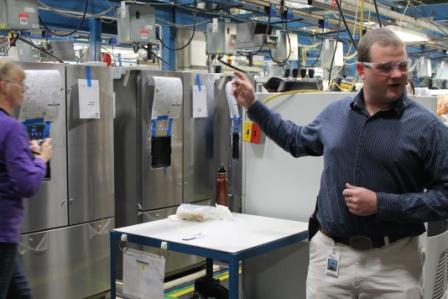
By David DeWitte
MIDDLE AMANA – They’re lean, green machines.
Leaders of the world’s largest appliance company came to the Corridor lastweek to announce that refrigerators from Whirlpool Corp.’s Middle Amana plant will be the first in the world insulated by a new, greener foam insulation with a drastic reduction in gases that contribute to climate change.
Whirlpool began using the new Honeywell Solstice Liquid Blowing Agent in November on one production line that produces the Whirlpool WRF 989 and WRF 990 models, the KitchenAid KFIS 29 model and the Maytag MTF29 model, company leaders said at a press conference Jan. 22.
By the end of 2014, Whirlpool plans to convert all its U.S. refrigerator and freezer production to the new, greener insulation, yielding a climate change impact equivalent to removing more than 400,000 cars from the nation’s roadways.
Joe Liotine, Whirlpool Corp.’s president of U.S. operations, came to Iowa to announce the “big advance in our environmentally-friendly technologies,” at a Middle Amana press conference last week.
“Global warming potential of the new foam-blowing agent is about 99.9 percent lower than the most common foam-blowing agents used widely within U.S. industry,” he said, “resulting in a more environmentally responsible household refrigerator.”
Mr. Liotine said Whirlpool Corp. has consistently improved the energy efficiency of its products, with today’s refrigerators consuming less electric power than a 60-watt light bulb. Whirlpool is the world’s largest appliance maker, marketing its products under the Whirlpool, Maytag, KitchenAid, Jenn-Air and Amana brands among others.
Tim White, leader of Whirlpool’s Amana plant, led a tour of the plant that included Iowa Economic Development Authority Executive Debi Durham and the visiting Whirlpool and Honeywell executives. Ms. Durham injected a touch of Iowa pride into the announcement.
“In Iowa, we pride ourselves on solving problems using innovation and ingenuity,” Ms. Durham said.
She said Iowa is ranked No. 8 on Site Selection magazine’s ranking of the most sustainable states.
Typically, insulation is applied to the interior of the refrigerator door panel and refrigerator cabinet in a liquid form at the plant. The insulation includes foaming agents that trap bubbles of gas inside the insulation as it expands and dries. At the end of life when the refrigerator is disposed of, the insulation eventually breaks down, allowing the gases to escape.
Honeywell researchers at the company’s Honeywell Performance Materials & Technology Center in Buffalo, N.Y., had been working for 10 years to develop Solstice and get it through lab testing and regulatory approvals, according to Sanjeev Rastogi, director of Honeywell’s Structural Enclosures business.
Solstice is 2-4 percent more energy efficient than the common insulating foam 245fa and safer to work with than a common refrigerator insulant, cyclopentane, because it is not flammable, said Andreas Kramvis, president and CEO of Honeywell Performance Materials and Technologies.
The new foam also flows better to reach small compartments of a refrigerator that are difficult to reach, according to plant operations staff members who use the material. It has higher insulating value than the insulation it replaces, and is expected to reduce reliance on more expensive vacuum panels for insulation in some parts of the refrigerator.
Insulation not only keeps the contents of a refrigerator cool, reducing the amount of time the compressor needs to run, but is also important for the structural support and strength of the box-like appliance.
U.S. EPA Region 7 Deputy Director John Smith came to Middle Amana to underscore the importance of attacking climate change and discuss the agency’s strategies. He said the EPA is reviewing new refrigerants and insulating foams with less potential to impact climate change through its Significant New Alternatives Program (SNAP).
Whirlpool Corp.’s 2,250 employees at Middle Amana produce about 4,500 units per day. The plant has four refrigerator production lines, and each line produces about 710 units per work shift, company officials said.




